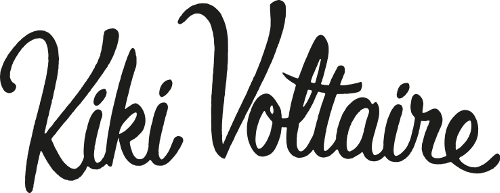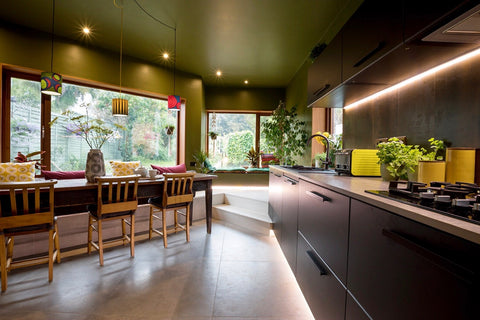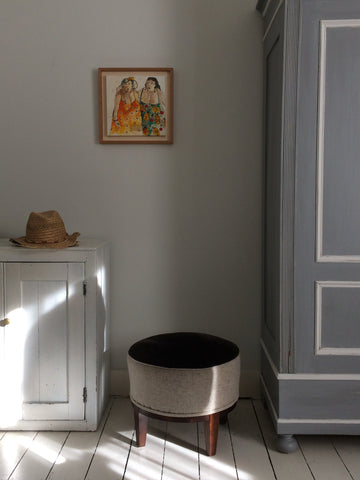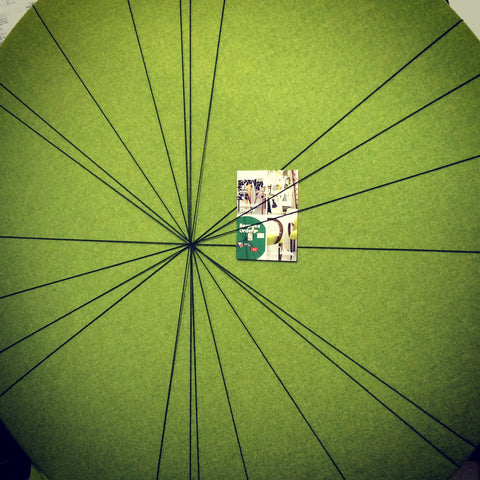News
Banquette Seating for Silvia and Julian's Brighton Home as shown on Your Home Made Perfect BBC2 TV programme April 29, 2020 07:00
Kiki Voltaire and Helen Atherton Designs have teamed up to help BBC2’s Your Home Made Perfect architect Robert Jamison transform a ‘rabbit warren’ 1940s house into a beautiful, contemporary home. The transformation was screened on the 7th April at 8pm.
We went back to visit Silvia & Julian's home at the end of 2019 and sharing some thoughts on their house renovation.
Silvia & Julian, Could you give us a bit of background on how you got involved with Your Home made Perfect TV program?
We bought the bungalow, as it was then, 5 years ago and I have to admit that I really did not see anything I loved about it!
Julian was absolutely sold on the garden. It has a beautiful long garden that although neglected, Julian had big ideas for this. In fact, I think that was the first thing he showed me when it came to me viewing the house.
It is/was a 1940’s bungalow with no particular features of that period and was a “warren” like living area. The most unlovable zone for me, as a person who loves to cook and prepare food for friends, was a very restrictive galley style kitchenette.
I am not entirely sure how I managed to get through 5 years of living here! There was always a plan that we would eventually change this and create a home that was in line with our way of living.
In 2015, we had a first floor built with 2 bedrooms and a bathroom. This improved the bungalow and our living so much, we knew we had to pursue with the downstairs.
We did engage several professional people to help us come up with something that we both had a “feel” for but no-one quite visualised what our hopes were.
I began to search out TV programmes that were like 100k house (but with a much smaller budget!) and came across one that was looking for contributors that matched the scenario we found ourselves in.
At this time, I knew nothing about who and what the project involved. I had seen an episode of a programme called I think, the 100k house and this amazing transformation of an old post office that a family had bought and had started to live in.
Robert Jamison was the architect who completely and radically transformed their space in such a way that I suddenly thought it could be possible that we could do something amazing with our bungalow too.
I found a programme that was looking for people who had a house that needed a compete transformation but that for one reason or another hadn’t happened.
Julian and I did have quite different ideas to each other, and this didn’t help in moving things forward.
We began the process with Remarkable TV in December 2017.
At this point we were aware of what the programme was hoping to deliver and who was involved. It was quite extraordinary that Robert Jamison was one of the two architects that would be involved!
Could you tell us about the house project and why you choose the proposal of the architect Robert Jamison?
When we were invited to the studios in London to see the ideas the architects had come up with, we were very nervous. The revolutionary concept of being shown the designs on virtual reality was incredible!
Robert’s was the first one we saw and it had a huge impact on both of us. It was an emotional one because it really did show us a vision that we had without having been able to actually visualise it. It so completely transformed the house in such an unbelievable way. We had no idea this kind of change could be possible.
Kiki Voltaire and Helen Atherton Design made the cushions for the banquette seating and curtains for you, how did we help you realise your project?
Robert's design is very considered, and the banquette seating seems a signature of his. As we had no previous knowledge of such seating and because it is such an important feature in our home it was essential that this was understood and created by someone who “got it”. As soon as we met Stephanie from Kiki Voltaire and Helen from Helen Atherton Design at the house, we could tell that by the way you were suggesting size, comfort and fabrics that you understood the importance of getting this right.
Your knowledge of material, the way they feel and work overtime was invaluable, as was your design and fabric expertise. You gave us plenty of fabric samples that we could choose from and helped us decide on the best way to achieve what we were after.
The huge curtain that separates the bedroom form the living area was so important as it has several functions to fulfill. It needs to feel luxurious yet timeless, create a “division” between the two zones and be insulating to sounds and temperature changes.
Your knowledge of materials and textures was invaluable, and we felt very confident when taking your advice.

What was the hardest decision you had to make?
Embarking upon the whole project! Moving out of our home was not easy and this was even harder as the project was several months late in finishing. We had no idea of how many decisions needed to be made on so many details!
Did we help you with your budget constraints?
We were aware that because the elements were bespoke, that we would not be able to buy ready-made furnishings, therefore we found it difficult to know what budget to allocate to the seating and curtaining. However, your quotes and communication during this process was always clear and when we had to make choices on the textiles to use, you gave great advice and cost-effective solutions.
Are you pleased with the fabric choice you made?
Delighted. It feels soft & luxurious. It is lovely to relax on and we have also found it is easy clean too! We have hosted many friends who feel the same!
How do you feel about the house now?
We are all very happy living here. The home is beautiful. welcoming and calm. We are finally re-united as a family (our son had to live elsewhere during the building works) and it really fits our lifestyle. No regrets!


Images provided by Remarkable TV.
Watch Silvia & Julian's Your Home Made Perfect, BBC2.
The Best of Brighton May 17, 2019 00:00
Brighton has been Kiki Voltaire home for the past 13 years and as we love this time of the year in Brighton, we thought it was time to write a blog with our favourite places around Brighton.
If you are planning a visit to Brighton this summer you can indulge in some culture, great shopping in the lanes, sea swimming (if you are brave) and a steady stream of great independent restaurants and cafes. Here are some recommendations!
Things to do:
A visit to the Brighton Royal Pavilion, an exotic palace built by King George IV and its Garden is well worth it.
For an adrenaline kick and some fun head to the Pier, you can hire bikes nearby if you want to explore the seafront on bikes. Then head to the promenade by the beach, some of it has been restored, some is still work in progress. As you get near the i360, which is fun to go up to, there is a piazza with a seafront sculpture constructed out of the old West Pier pillars and a plaque commemorating its designer, Eugenius Birch. The West Pier only offers the remains of its metal structure but is still beautiful and remains the city’s most photographed landmark. For the best photos of Brighton and the Sussex South Downs, head to Brighton Photography Gallery on the row of shops near the i360.
If you carry on walking or cycling by the sea, you will head toward Hove Lawns where you can exercise, play ball games, hire one of the City bikes or go onto the beach as there are several areas where the lifeguards will keep an eye on you and your family.
Off the Beaten Track:
Cycle to Ovingdean beach via the undercliff walk.
Try the Sauna Beach Box on the Madeira drive.
Take the Breezer 77 bus to The Devils Dyke for a walk on the Southdown way.
Head to Stanmer Park (Bus 25 or 78) for a forest walk or to make your way to the South Downs.
In town, visit:
Brighton Victorian Sewers – An exceptional feat of underground engineering
Fabrica Gallery – A contemporary art gallery in a Regency Church in the South lanes.
Or celebrate Quadraphenia 40th anniversary by visiting Quadrophenia Alley – Off East Street – Quadrophenia concert is on 24th August at the Concorde
Shopping:
Where to start! Brighton offers a great choice of the usual high street chains but where you want to head to is the Lanes where you will find an excellent choice of small independent shops.
If you are coming by train, pass under the bridge to Trafalgar Street on your way to Sydney Street and the North Lanes. On your way, at No37, Sirene is lovely women’s shop, further down at No23, Magazine Brighton, is selling independent and inspiring magazines (not the type you will find in WH Smith).
Take a right onto Sydney street and then get lost or try visiting some of our favourites:
Fold is shop selling clothes made my independent makers using beautiful textile. Dirty Harry for vintage clothing, Pen to Paper for beautiful pens and quality note books. If you go to Gloucester Road, Tidy Street has a great range of boho clothes and presents, Dowse, is great for ceramics and gifts. Head to Kensington Gardens, stop at Resident Music if you are looking for a vinyl or CD. We love Junior Edition for kids clothes and presents, and Abode for home interior and gifts. At the end of the street you will see Food Infinity, a worker co-operartive and great vegetarian shop which is an institution in Brighton! On Gardner Street you can pop into the Photomatic shop for some fun photos, if it’s raining the Komedia Picture House Cinema will offer a great shelter with comfy seats for a few hours, alternatively stop in any of the local cafes if you feel hungry or for an ice cream head to Gelato Gusto for an artisan ice cream. On Bond Street, we love TriBeCa for Women’s fashion and Lavender Room for boho women’s fashion and gifts. You can cross North Street, which I would ignore, and join the South Lanes, stopping as you wish and making your way to the seaside.
Restaurants and Bars:
You could start your day with breakfast at Silo, a sustainable restaurant on Upper Gardner Street near the North Lanes (closing shortly though). For lunch there are many cafes to tempt you with or try Fatto A Mano on the corner of Kensington Garden where kids eat free! If you make it to the seafront, we like Lucky Beach, right by the beach, for its burgers and great healthy drinks but it can be hit or miss on a busy day!
For dinner there is an amazing choice, but you will need to book well in advance, especially at the weekend.
Our favourites are: Cin Cin Brighton or Hove, for amazing Italian cooking and pasta with an open kitchen! The Gingerman in the centre of town, 64 Degrees serving innovative small plate dinner cooked by award winning chef Michael Bremner. The Set Restaurant is part of the Artist Residence on Regency Square and has an open kitchen with a choice of seasonal modern British food. Terre A Terre, is an award-winning vegetarian restaurant on East Street. Riddle and Finn (The Oyster bar In the lanes) for local fish and seafood. Bincho Yakitori, a great Japanese restaurant with an open kitchen, cooking their food on a charcoal BBQ and modelled on Izakaya (boozy Japanese taverns) is one of our favourite and offers exceptionally tasty food for a reasonable budget. It is also vegan friendly but this is true of most Brighton's restaurants. All those places are popular and need to be booked well in advance.
If you still have energy for drinks, our favourite cocktail bars are The Plotting Parlour near the Pier, The Fix (previously named The Cocktail Shack) on Regency Square. L’Atelier du Vin has moved to near St Peter’s church but we haven't tried it yet!
And have fun! Brighton is full of fun, friendly and creative individuals who will happily converse with you.
Why buying vintage furniture is good for you and the environment. April 11, 2019 10:45
The trend for vintage furniture and decorative objects is still going strong. Added to this a “conscious consumption” movement which is gaining strength and a populous rediscovery of traditional craftsmanship, it makes perfect sense to buy vintage furniture for your home or office space.
Creating an individual interior
Over the last 15 years people’s love of buying vintage or retro furniture has grown and that trend is set to continue. Buying furniture made in the past 100 years gives you the opportunity to create a unique and stylish interior decor with a strong personality and a sense of history. Whether you mix pieces from different eras, re-create an interior in the mid-century style or mix old and new it will be an individual look!
Environmentally friendly
As well as beautiful aesthetics, vintage furniture has great environmental benefits. To start with you are preventing furniture from going to landfill. It is healthier for your home – as the furniture will have finished releasing the toxic fumes present in the finishing and glues. As we are more aware, the pollutants in our homes this is not negligible. If your new piece of furniture needs restoration, use natural materials where possible or discuss this with the artisan who will restore it for you.
Craftsmanship
Most of the vintage furniture which is still around and in a good condition tends to be well made some from solid wood, like our collection of Bridge chairs. You can test the quality of furniture by checking for sturdy frames, woodworm (which can be treated if not too extensive), drawers which run smoothly etc. Generally vintage furniture is less expensive than buying new furniture of the same quality.
If you need to restore the furniture, you can take it on as a project with the help of a couple of self-help books, a local community class, or alternatively, seek the help of a furniture restorer or upholsterer. The latter may require a bit more investment, but either way you will end up with a unique piece of furniture and preserve its history for less than buying a similar piece new. And it will last many more years!
2018 Interior Trends - How to use pop colours and geometrics patterns in your home May 21, 2018 14:49
If you are thinking of updating your interior decor here are a few on tips on current trends.Wool Renaissance October 12, 2017 19:32
Wool Renaissance
There is a wool renaissance in interior decor and it’s back on the trend. Wool Week is a perfect opportunity to re-state the great benefits of one of Kiki Voltaire’s favourite materials that has been used on our Contemporary Notice Board Collection since its launch.
The Campaign for Wool states 10 Wonderful Reasons to LOVE WOOL
- Pure wool - 100% renewable, 100% sustainable, 100% biodegradable. If you love the planet – use more wool.
- Sheep are amazing – they graze peacefully, grow wonderful wool, we use it to make beautiful textiles and the whole process begins again… no depletion, just sustainable and sensible.
- Wool feels luxurious, it’s reassuringly soft, warm and confortable.
- Strong and long lasting – it is durable and robust and its elasticity enables it to spring back into shape. Wool carpets and rugs can take lots of heavy wear and are known to look better for longer – quality always last!
- Insulate with it, sound proof with it, wear it, walk on it and wrap things with it. The world’s oldest renewable fibre is also the most versatile and modern.
- Wool has hypoallergenic and anti-bacterial properties. Wool is a natural fibre; organic and resistant to bacteria. It makes the air that we breathe cleaner and better.
- It is warm but it is cool because it adapts to the wearer – that is why sheep are so snug and content! Wrap your babies in wool… because it breathes easily it will keep them cosy and warm, but not too hot, as it cleverly changes to their needs.
- Fire retardant – wool is flame retardant and will often self-extinguish. Fire fighters like wool because it produces less smoke and toxic fumes – making it a safer choice for the home and offices.
- Wool has acoustic property, noises that surround us are reduced as wool absorbs sound.
- Carbon efficient – an effective insulator, wool will reduce the need for heating and protect against heat loss making it highly carbon efficient.

Kiki Voltaire loves wool… we use pure wool in our Contemporary Notice Board Collection, Felt Wool Notice Boards, Bespoke Headboards and Chairs.
Cork oak, the miracle tree September 27, 2017 04:23
Cork oak, the “miracle” tree
In 2015 I visited a wonderful exhibition at the Villa Noailles in Hyeres (France, Var), it is run yearly and is designed to rediscover raw natural resources from the Provence Cote d’Azur region, it was all about cork. Traditional artisans and young designers talked and exhibited their creation made of cork.
Maurice Junque, who runs the last regional establishment to grow cork manually in the Var region, talked with passion about the “miracle tree” because it is “fire retardant and self regenerates. But without human intervention to strip its bark, it would gradually disappear and the biodiversity of forest would be threatened”.
Artisans and designers who love sustainable material and want to keep alive the local “savoir-faire” (know how) are working hard to find new uses for this wonderful material. Indeed, since 1991 the European Union legislation is imposing synthetic corks for ready to use wine and the traditional market of cork bottle stoppers has now shrunk to almost nothing.

Why cork is a wonderful material
Cork is an impermeable and elastic material. The layer of bark that is harvested for commercial use, primarily from cork oak (Quercus suber), is endemic to southwest Europe and northwest Africa.
Because of its impermeable, buoyant, elastic, and fire retardant properties, it is used in a variety of products, the most common of which to date is wine stoppers.
Portugal produces approximately half of cork harvested annually worldwide. Other producers are Spain, Morocco, Algeria, Tunisia, Italy and France.
Cork Harvesting
Once the trees are about 25 years old the cork is traditionally stripped from the trunks every nine years, with the first two harvests generally producing lower quality cork. Bark from initial harvests can be used to make flooring, shoes, insulation and other industrial products. Subsequent extractions usually occur at intervals of 9 years, though it can take up to 13 years for the cork to reach an acceptable size. The oak cork trees live for about 300 years.
The workers who specialize in removing the cork are known as extractors. Nowadays, the Portuguese workers travel Europe to extract cork. Sadly in France, as the cork industry has greatly shrunk, we don’t know how to lift the cork anymore. Currently, the company Corticeira Amorim, is the world leader in the cork industry.

Environmentally friendly
Cork oak forests prevent desertification and refuge of various endangered species. The cork production is considered sustainable because the cork tree is not cut down to obtain cork; only the bark is stripped to harvest the cork. The tree continues to live and grow. Cork products and its by-products are also easily recyclable.
Cork uses
Cork's elasticity combined with its near-impermeability makes it suitable as a material for bottle stoppers, especially for wine. Cork stoppers now represent about 60% of all cork-based production.
Cork's structure and natural fire retardant make it suitable for acoustic and thermal insulation in houses. The by-product of more lucrative stopper production, cork board is gaining popularity as a non-allergenic, easy-to-handle and safe alternative to petrochemical-based insulation products.
It is also use in badminton shuttlecocks, baseballs and cricket balls, fishing floats, cork is often used as an alternative to leather in handbags, wallets,and other fashion items. In the South East of France, the “Couasses” is a large hollowed piece of cork used as a dish to serve the Bouillabaisse.
In 2015 Ikea launched Sinnerlig a collection of stools, benches and table mat made of cork designed by interior designer Ilse Crawford.
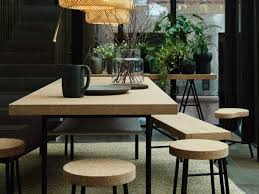
And of course, at Kiki Voltaire we use cork as backing for our notice boards so that you can pin into them. In our latest collection, a collaboration with Cath Bristow a fine art print maker, the cork material is at the fore-front and Cath has used cork sheets to print her designs onto it.
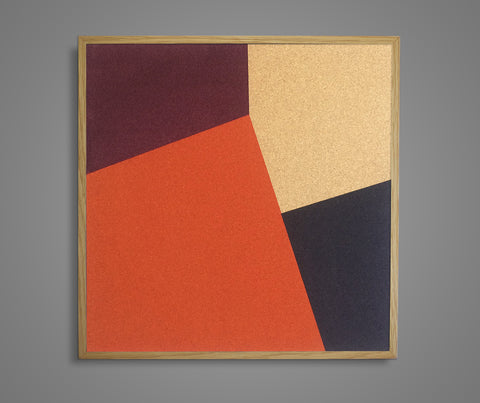

References: Wikipedia & Villa Noailles.
Josef Frank, Architect, Furniture and Textile Designer May 3, 2017 23:47
I have recently been to see the Josef Frank Patterns: Furniture-Paintings' exhibition at the Fashion and Textile Museum in Bermondsey, London. The exhibition show cast his patterns, furnitures and less known watercolour paintings.
The exhibition is on until the 7th of May.

Josef Frank, famous for his vivid and bold textiles designed mainly for Sventskt Tenn, was born near Vienna in 1885. He studied architecture at the Vienna University of Technology and after the WWI became a professor of architecture as well as successfully practicing architect. In 1925, he founded the design and furnishing firm Haus & Garden, successfully designing house, furniture and fabrics.

Textile collection
Frank left Vienna in 1933 due to the growing anti-Semitism and went to live in Stockholm with his Swedish wife, Anna. He collaborated with Estrid Ericson at Sventskt Tenn from 1934, designing textile patterns and furniture that are now considered "Swedish Modernist" Classic.The duo exhibited at the Paris Word Expositions in Paris (1937) and in New York (1939), showcasting their bold contrast interiors which was in complete opposition to the trends of the time.
Most of Frank Josef's textile and furniture are now distributed by Sventskt Tenn and you can find more information on their website.
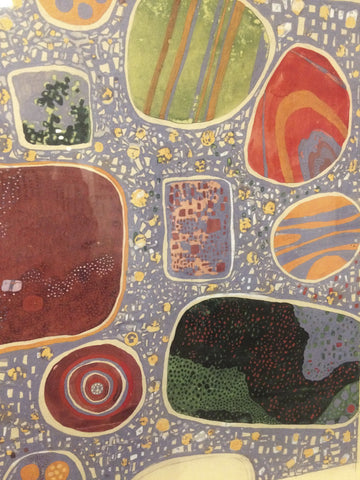

Above are images of the Terrazzo Design (1944). The watercolour design (left) and the fabric (right). Departing from familiar nature themes, the new inspiration for the Terrazzo design was a Italian mozaic terrazzo floor pattern.
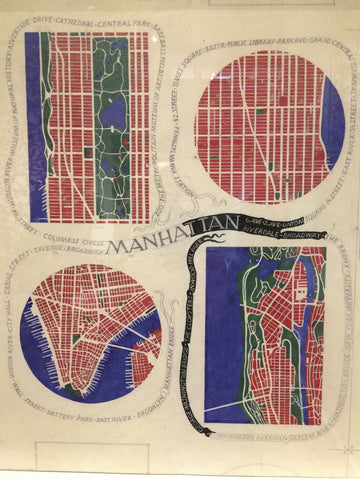

Map of Manhattan design in watercolour (left) and Fabric (right:). Josef Frank lived and worked in Manhattan, New York from 1941-1946. He found Manhattan’s city plan so interesting in its simplicity, that he created the Manhattan print.
My favourite design is the Teheran (1940), an interpretation of Persian Carpet first printed in 1991.

Josef Frank's paintings
Josef Frank had always use watercolour in designing his textile patterns, but started painting landscapes, cityscapes and still life in the 1950s when commissions for architecture projects and interiors were becoming fewer. No one was aware of the extend of his output until recently. A large part of the collection was painted during summer holiday in Provence.
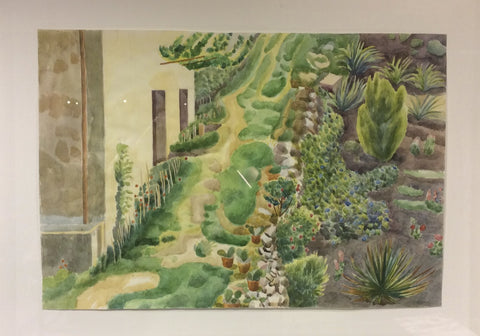
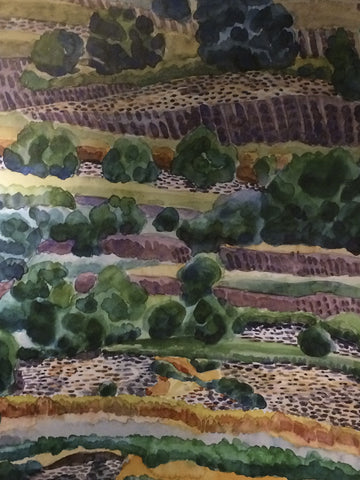
Links:
Fashion and Textile Museum
http://www.ftmlondon.org/ftm-exhibitions/josef-frank-patterns-furniture-painting/
Svenskt Ten
https://www.svenskttenn.se/en/since-1924/josef-frank/
Recent article on Josef Frank
https://www.theguardian.com/lifeandstyle/2017/jan/14/josef-frank-swedish-design-fabrics-furniture
24 hours in Bath: Spa, Culture, amazing food & drinks, and a textile discovery March 25, 2017 16:21
I have indulged in a few mini breaks lately. They offer the fresh perspective needed to be creative and often I come back inspired and raring to get back into my studio.
My last mini break was last weekend, when I went to Bath to see my friend and actress Emma Beattie in The curious incident of the dog in the night time. The award winning NT play which, to quote the author Mark Haddon, “is a novel about difference, about being an outsider, about seeing the world in a surprising and revealing way. The book is not specifically about any specific disorder”. The play is currently on tour in the U.K and about to go on an international tour.
Where to relax in Bath
On my arrival from Brighton, we went straight to the Bath Thermae Spa. It has mixed reviews but we both love spa experiences so were ready to try it! Unfortunately the steam rooms are currently being renovated until the end of March 2017, but this entitles you to a free re entry voucher. We arrived just before the Friday late afternoon rush so it wasn't too busy and we had a lovely, and fun time!
Where to Eat & Drink in Bath
We came out refreshed and hungry for our dinner at the award Winning, scallop Shell. It has a modern and warm interior with a fish counter you can choose from, a great menu and a nice wine and beer list! I went for a grilled sole but Emma had the haddock fish & chips and both were divine!
Whilst Emma was getting ready for the play I had a drink at the lovely and (prope, excuse my French) Vino Vino wine bar which is next to the Theatre Royal. The Oven, the award winning pizzeria next door, smelled delicious and customers were raving about it when leaving the restaurant.
Now, it was time to see the play, which was amazing. A beautiful insight in the mind of a teenager with behaviour issues having to cope with life challenges. I also loved the theatre, which has been restored whilst retaining its original design and features.
After the show we went to The d'Ark Horse, an underground cocktail bar. An intimate bar with a nice atmosphere and friendly service. They follow the current trend of serving beautiful cocktails using local ingredients.

Where to shop for interior in Bath
Saturday morning after a visit to The Thoughtful Bakery for coffee and breads (like beetroot bread and wraps!!), yumm yum! But now it was time for some shopping so we went first to Milson Street, where the Morris dancers were performing. We visited Savannah Home Store , of course, I love interior shops, especially when they offer something unusual. Savannah Home store currently have for sale wingback chairs upholstered in died silk velvet fabric and a collection of cushions and throws. The fabric is designed and made by the former textile designer for Galliano and McQueen. Her fabrics are a work of art and fashion history. I have been on the hunt for some new cushions in an original nice fabric so I may have found them!


We then went to Hay store, who designs and makes contemporary furniture with an eye for modern living and sophisticated industrial manufacturing. I discovered Hay in Copenhagen 10 years ago, when I travel back home with bags of cushions (that was the time of unlimited luggage being allowed on the plane) and I am still a big fan! This year I particularly like the yellow accent.
We then had a brunch at the Wild Cafe, serving breakfast all day and It was time for my 13.01 train to Brighton and Emma's matinee show.
I feel like every time I come to Bath, there is so much more to discover. I will be back soon!!
Bridge Chairs May 3, 2016 00:06
Kiki Voltaire has been sourcing and restoring Bridge Chairs - Fauteuil Bridge - from France for nearly 10 years. Bridge chairs were originally designed in the late 1930s for ladies of leisure for games of bridge, afternoon tea and gossiping! The chairs are stylish, of small proportions, well made and extremely comfortable. Manufacturing continued until the 1950s.
Bridge chairs have a small compact size which makes them easy to use in most rooms - suiting a bedroom, office or even to accompany a dinning table. The frame is usually constructed in beech timber and on occasion oak - typically finished in natural wood or stained.
We often take delivery of the chairs covered in bicast (artificial) leather but we have also seen several interesting covers over the years!



We remove the entire upholstery as the springs and the padding are not so comfortable after 70 years! We also restore the wood, by cleaning or even removing the existing finishing which is often very dirty! This process can take several days - a real labour of love. Then we re-upholster the chair.

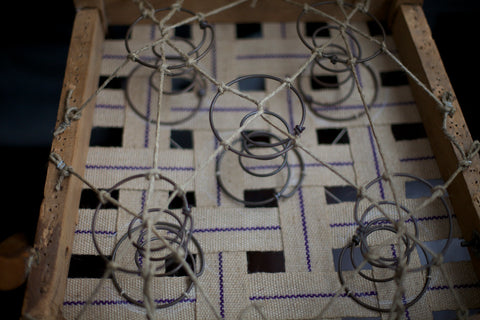


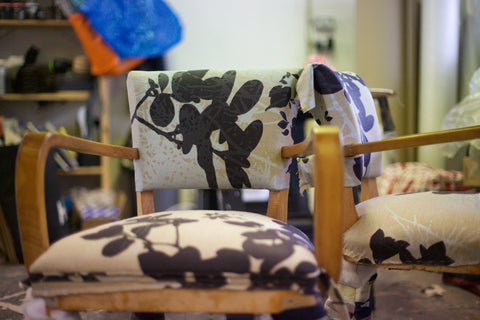
The final step is to decide on the fabric to finalise the design!



If you fancy learning how to restore Bridge Chairs and practice your French at the same time, check out these classes run by by Etienne Champenois of the Stage-Tapissier in Paris and Uzes.
For additional information on Bridge Chairs, check this blog by Capella Kincheloe were you can see a pair of our very early Bridge Chairs in Pink Camira fabric.
Bespoke Notice Board's design journey February 22, 2016 21:17
Kiki Voltaire works regularly with individuals and interior designers to create bespoke notice boards. In this blog we’ll explore some of the recent commissions we have made in our Brighton’s studio and discuss the design journey.
Size, colour, style and situation…
Our customers often have a good idea of the size and colour they are looking for, and usually they brief me on the room and interior style. As well as going over the decor (colour palette, style), we also discuss who will use the notice board and if it’s for a specific purpose (such as displaying kids’ artwork). Using Skype or FaceTime video calls has also been a very effective way of seeing the room, style and other furnishings to help the design process.
Interior designers provide us with a full brief, including drawings, colour palettes and required measurements – for example of a cabinet or a specific space the notice board must fit within.
Fabric & finishing…
Kiki Voltaire has a strong preference for natural materials and we work mainly with linen and wool for our notice board collection. Linen is a beautiful material made from the fibres of the flax plant, it’s natural qualities make it easy to work with for upholstery work. The flax fibres and weaving process causes little "imperfections", which we think add to the appeal. Our supplier offers a choice of over 30 colours – here are just a few…
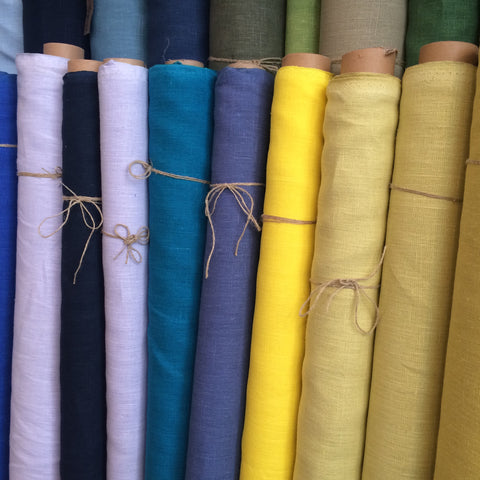

We also use wool fabric from Moon Fabrics, mainly from their Melton Collection. Their felt wool is made in Moon’s mill in Yorkshire (UK) and is truly beautiful, hard-wearing and slightly stretchy – so perfect to use on our contemporary notice boards, but also for upholstery. It is available in a wide range of colours and we love it!

To compliment the fabrics Kiki Voltaire uses a collection of vintage ribbons we have acquired over the years, grosgrain and woven ribbons which are sourced from suppliers such as East of India and Jane Means. Our wide range of elastic bands used on our contemporary notice boards are sourced from Japan.
We offer the option to add cork backing to our notice board for customers wishing to use pins.
This are some of our recent commissions.


